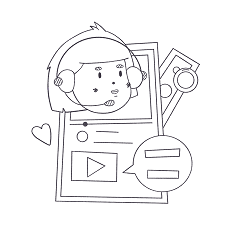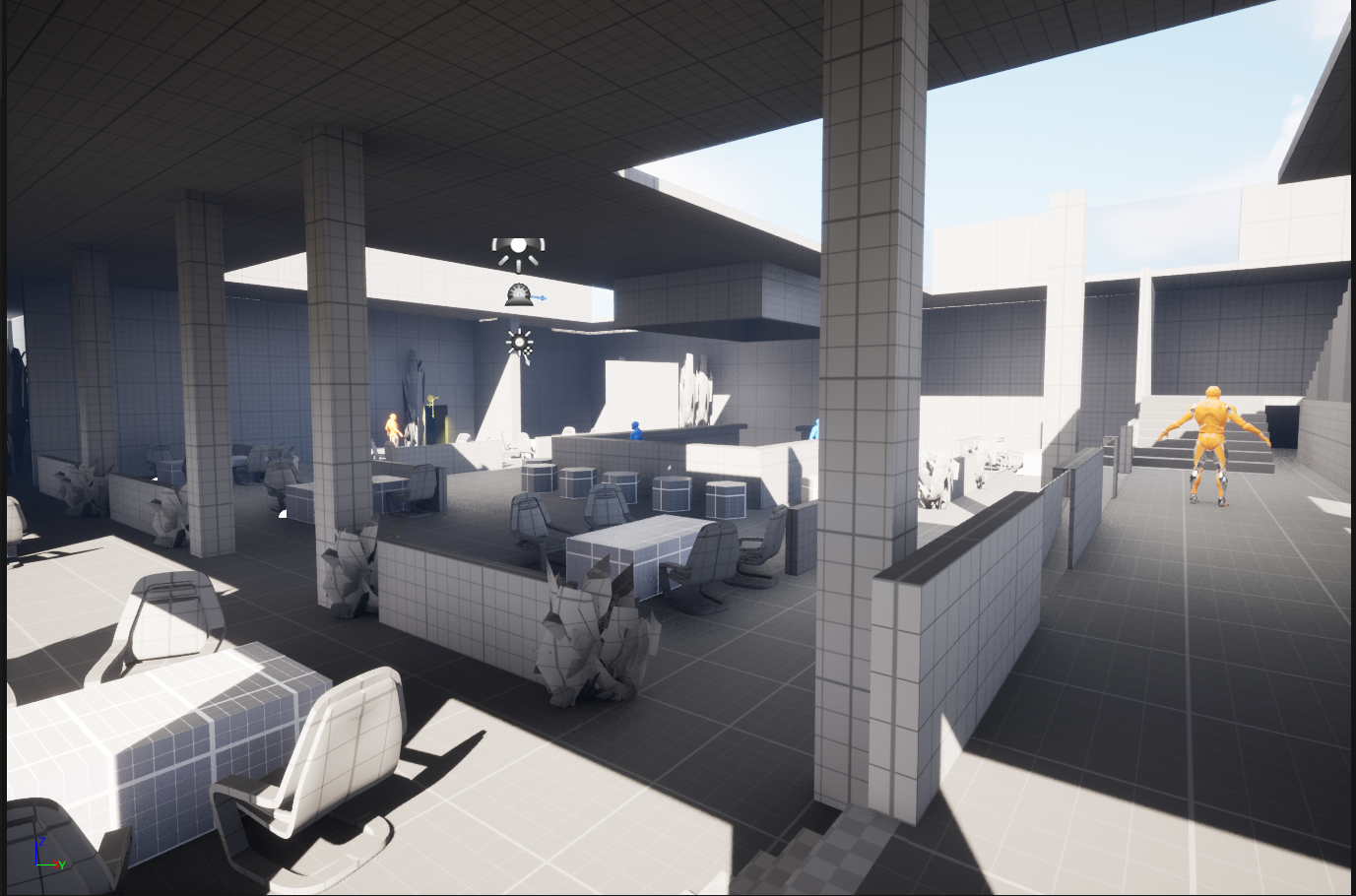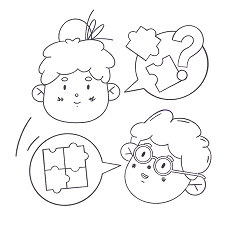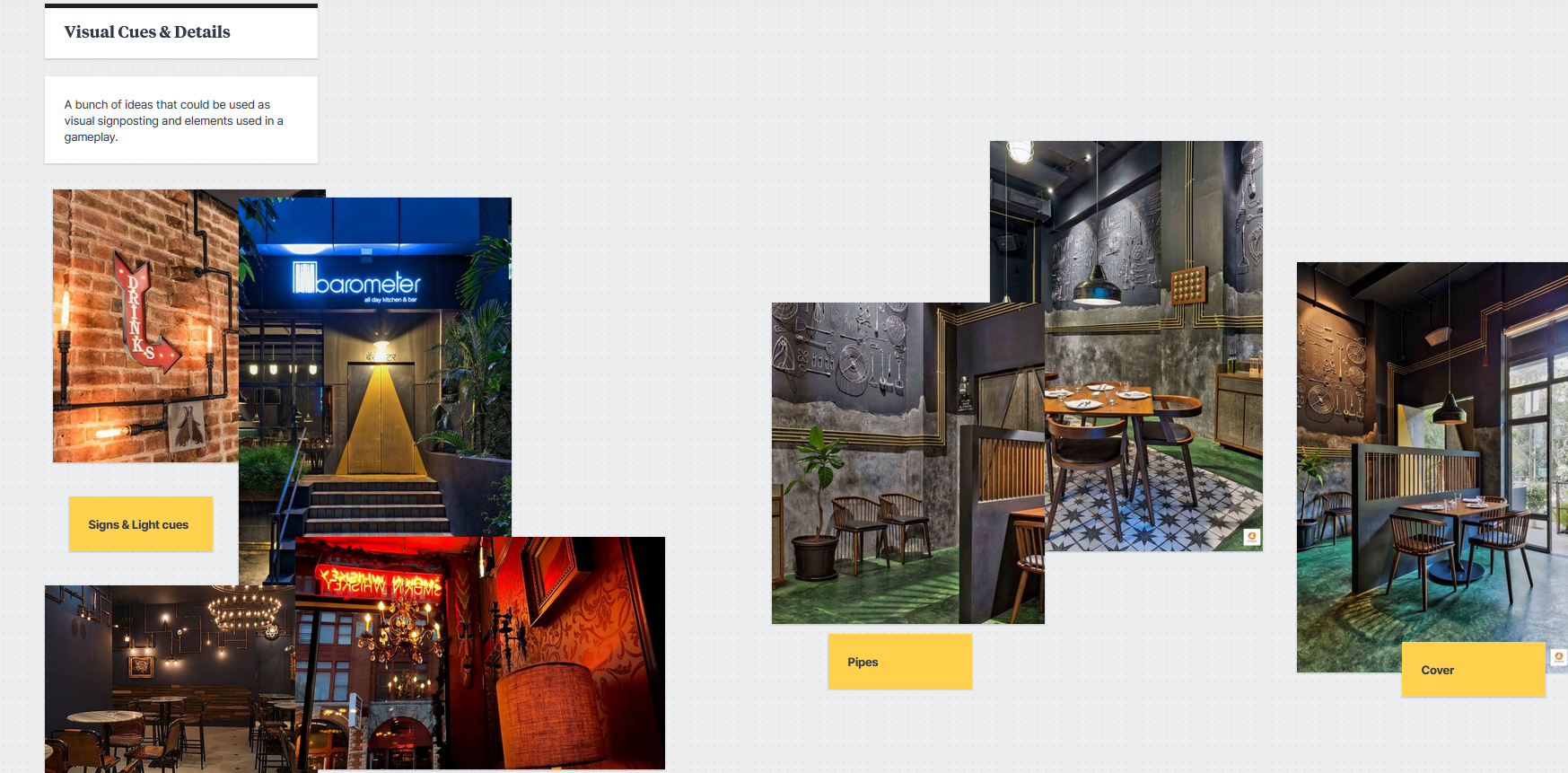Leveling up in level design: Resources & recommendations
08 July 2022
Back in April 2022, I was adamantly convinced that I don’t have a speck of design thinking in me and am artistically dumb as clay. But I wanted to learn how to build levels in video games. Three months later, I’ve landed a game design internship at Warhorse Studios (we’re hiring!), and as we speak I’m bridging the gaping gap of being a total noob to becoming a junior level designer. I still have so, so much to learn about level design but I’ve been told I am good at it, so I’ll keep leveling up.
Along the way, I’ve built a database of resources, discovered awesome communities, and surrounded myself with a network of people that have helped me, both directly and indirectly, with becoming a level designer. This post is all about appreciating those connections and sharing all the resources with others.
This is not at all a guide on how to break into the game industry. In the best possible scenario, this post will give you an idea of where to go next and what this discipline entails. I put these resources together because I wish I had something like this when I started my own journey.
Enjoy!
> Level design theory
I’ve noticed that what makes a level designer stand out is not only years of practice and games they’ve played (and sub/conciously analyzed along the way) but also the theoretical background they’ve obtained in game design or fields related to it. It does make a big difference when you know your “whys”. Which sources are worth engaging with, though?
Game design as a field is backed up by a substantial body of theories coming from psychology, architecture, sociology, information technology, and other domains. Game design pretty much borrows something from everywhere.
You don’t have to master each of the fields, nor you have to read academic papers produced by scholars. However, your willingness to learn about even the basic concepts from different sources will pay off.
Here’s a list of what I recommend to read, listen to or watch.

Books & Articles
The myriad of resources available these days about game design can feel indimidating. My origins are in academia, so I tend to blend both research-based books and practice-oriented ones to get the maximum out of what I read. I also understand that not everyone is a fan of research books, as approachable as they tend to be lately. Don’t worry, all of the below books are accesible and highly enjoyable, so…choose your proverbial poison!
Game design & Level design
Most of the game design books talk about why people play, what games are and how people design them; what is the general mentality of players, what they expect, and what keeps them in the loop despite failing. Level design books talk specifically about what level design is, how to approach it, formalize it and get better at it. These are one of my favorites and also seminal works for understanding what we mean when we say game or level design specifically.
- Jesse Schell: The Art of Game Design: A Book of Lenses
- Salen & Zimmerman: The Rules of Play
- Katherine Isbister: How Game Move Us: Emotion By Design
- Pete Echells: Lost in a Good Game: Why We Play Video Games and What They Can Do for Us
- Jesper Juul: The Art of Failure
- Mia Consalvo: Cheating: Gaining Advantage in Videogames
- Brian Upton: The Aesthetic of Play
- Rudolf Kremens: Level Design: Concept, Theory, and Practice
- Christopher W. Totten: Level Design: Processes and Experiences
- The Level Design Book online project
Design
Some of these books are considered to be the design canon and explain what design and design thinking is. Since players use mental models and maps to orient themselves in gamespaces (among other things), I’ve also included books about the topic. Some color theory is also handy to know about.
- Donald Norman: The Design of Everyday Things
- Donald Norman: Emotional Design: Why We Love (or Hate) Everyday Things
- Eli Woolery: Design Thinking Handbook
- Indi Young: Mental Models: Aligning Design Strategy with Human Behavior
- Peter Gould: Mental Maps
- Steve Krug: Don’t Make Me Think
- Susan Weinschenk: 100 Things Every Designer Needs to Know About People
- A. & J. Eckstut: The Secret Language of Color
UX Research & Psychology
Building levels is basically all about being cognizant of various principles of human psychology and being able to leverage them. Celia Hodent’s books are essential to understand gamer’s psychology and how the mind drives their perception and behavior.
- Celia Hodent: The Psychology of Video Games
- Celia Hodent: The Gamer’s Brain: How Neuroscience and UX Can Impact Video Game Design
- Celia Hodent: What UX is Really About
- Rudolf Arnheim: Art and Visual Perception: A Psychology of the Creative Eye
- Anders Drachen: Game User Research
- Jamie Madigan: Getting Gamers: The Psychology of Video Games and Their Impact on the People who Play Them
- Daniel Kahneman: Thinking, Fast and Slow
- Dan Ariely: Predictably Irrational
Architecture & Urbanism & Level Design
Level design means you’re inevitably signing up for learning bits about architecture, interior design and urbanism. These books should help with it.
- Alison Gazzard: Mazes in Videogames: Meaning, Metaphor, and Design
- Christopher W. Totten: Architectural Approach to Level Design
- Von Borries: Space Time Play: Computer Games, Architecture and Urbanism: The Next Level
- Matthew Frederick: 101 Things I Learned in Architecture School*
- Matthew Frederick & Vikas Mehta: 101 Things I Learned in Urban Design School*
- Architecture & Design LinkedIn inspirational page with more than 175k followers
Ethical game design & Representation
Designing anything comes with a great responsibility. I’m not joking. Designers implement values in what they create automatically, quite often without thinking about it. Knowing that games have embedded values and how to design with them in mind is important, so is knowing about representation in video games.
- Karen Schrier: Ethics and Game Design: Teaching Values Through Play
- Flanagan & Nissenbaum: Values at Play in Digital Games
- Adrienne Shaw: Gaming at the Edge: Sexuality and Gender at the Margins of Gamer Culture
- Shira Chess: Ready Player Two: Women Players and Designed Identity
- Mike Monteiro: Ruined By Design: How Designers Destroyed the World, and What We Can Do to Fix It
Websites of level designers
These days a lot of level designers share their knowledge online either via websites or social media like Twitter. Below are a couple of them I follow, but I recommend doing your own searching to find those designers whose work you’re interested in.
- Max Pears | website
- Clement Melendez: Push and Pull | website
- Tommy Norberg: Level Design tips | website
- Matthew Bradley: Matt Does Design | website
- Alex Galuzin | website
- Iuliu-Cosmin Oniscu | website
- Andrew Yoder | website
- Bobby Ross | website
- 80.lv | website
Other
Game industry is not just unicorns & rainbows, so to speak. It’s a fast-paced environment that requires a mindset combining creativity, commitment and acceptance of frequent changes. It can be a lot to take in. These books give a good glimpse into the behind the scenes of ups & downs in game development.
- Jason Schreier: Blood, Sweat, and Pixels
- Jason Schreier: Press Reset
- Walt Williams: Significant Zero

YouTube & Twitch channels
All hail YouTube, the place where people explain everything in a fun way! (Unless you end up in a rabbit hole of conspiracy theories…). Most channels I’m subscribed to discuss game design, AI in video games, while some specifically focus on level design. I’ve also added channels of Game User Research Special Interest Group (GRUX SIG) because they often share their research findings that can be often generalized on a variety of games.
- AI in Games (Tommy Thompson) | website
- Game Maker’s Toolkit (Mark Brown) | website
- Talking About Level Design (Steve Lee) | website
- NoClip crew’ Video Game Documentaries | website
- Tostspender (Miles Tost, CDPR) | website
- PaweSasko (Pawel Sasko, CDPR) | website
- Game User Research SIG | website
- Game Developer Conference | website
Miscellanous talks & articles
- David Shaver (Naughty Dog) & Rober Yang (NYU professor): Level Design Workshop: Blockmesh and Lighting Tips
- Richard Lemarchand (Naughty Dog): Attention, Not Immersion
- Elisabeth Beinke-Schwartz (Certain Affinity): Level Design Workshop: Singleplayer vs. Multiplayer Level Design: A Paradigm Shift
- Hugo Bille: The Invisible Hand of Super Metroid
- Emilia Schatz (Naughty Dog): Defining Environment Language for Video Games
Podcasts
- Level Design podcast
- The Game Design Roundtable
- Play Watch Listen
- The Psychology of Video Games
- Designer Notes
- Level Design Lobby
> Tools & workflow
Everyone’s path is different and so will be the tools you’ll use and your workflow. There’s no industry standard (as far as I know) how one goes about designing a level but some parts of the process will be common to everyone. Below is the rough description of how I approach it when designing a level – I work with Unreal Engine 5 and my focus is 3D levels without a specific game genre in mind. As I’m still learning, take these recommendations with a grain of salt. They work for me, might not work for you.

Pen & paper
Planning to do a 3D level? As soon as you have an idea, sketch it on a piece of paper. It doesn’t have to be perfect (look at my rough sketch below, a three year old could have made a better one) but your sketch should give you an idea what you’re working towards. You’ll get a general notion about dimensions, division of space, where you want your objectives or enemies to be placed, etc. Be 100% sure you will move away from the original draft but the first sketch will help to ground you.

Moodboard
Surprisngly, moodboards are not just for concept artists and environment designers. You will benefit greatly from using references and moodboards to capture the essence of the style, details, and even functional decorations of your level. When designing a high-society restaurant the other day, I put together a moodboard of references as one of the first steps. The pictures guided me in how open the space should be, what’s the disposition and style of the area, etc.
I usually use Milanote (it’s pretty, yet functional!), Miro will do too and some studios use it as a standard for sharing creative ideas within a team. If you’re looking for a desposit of references beyond Google, I encourage you to exploit the recommendation algorithms of Pinterest. You’ll find a lot there!
Engine
Before I started working in Unreal Engine 5, mainly because of its rising prevalence in the industry, my weapon of choice was Unity. I was mostly using it for learning how to script but for whatever reason Unity just wasn’t working for me level building-wise. Switching to Unreal has made all the difference.
You might be a Unity person, maybe you prefer Unreal Engine, or even Godot will work better for you. If you’re into 2D, there are options like Construct. Try a couple of them and you’ll see which one feels the best. It’s also totally okay if you stick with building paper models and making games that way.
Also, if you ponder on “how to” with each tool, look for the communities and tutorials supporting them online, either via the product’s official website or on YouTube, Udemy or Coursera.
Blockout tools
Blockout is the process of using basic objects (“blockmeshes”) provided by the engine to create a waterdown version of a level you plan to build. Think, gray boxes put together to create a space like this one:

I learned the hard way that in blockout, less is always more. Initially, I thought I should use all the intricate and detailed 3D assets I can find and even buy. What often happened was that instead of building a level I ended up decorating it.
Instead, teach your brain to think in basic shapes and use them to create a space you want, some details included. Don’t have a table? Use a rectangle of the same length and height. Don’t have bar stools? Use cones. Rinse. Repeat. The main goal of blocking out is to convey information in the cleanest way possible. You can always add the rest later.
Also if you’re interested to see how detailed or abstract a blockout can be, I recommend following hashtag #Blocktober and a Twitter handle @BlocktoberLD. Every year during October, level designers from around the world participate in this challenge and showcase their work.
> People skills
If you want to work in gamedev so you can make games and escape talking to people, I have some bad news for you. Communication and so called “soft skills” are essential for thriving in this environment and succesfully working with your own team members or colleagues across the studio.
Hone your soft skills
As I’ve learned recently, the usual set up of a team working on a game location consists of people from different teams. Let’s say you have a task to figure out a stealth mission in an industry compound. In different stages of developing and iterating on the location, you’ll have a quest designer, level designer, gameplay designer, environment artist, scripter, producer, QA tester all working together. And all of them need to be on the same page throughout the process. Communication really is the key skill here, in gamedev especially.
As a somewhat shy, usually awkward and mostly introverted person, I recommend step-by-step pushing yourself out of the comfort zone if you’re not naturally a people person. You will have to communicate with people and you will have to do it often. Communicating your ideas in clear and decisive way is really important because time is money and there’s no room for confusions. If you’re not good at small talks but want to connect with people, be genuinely interested in their work and ideas, and ask them about it. Not only will you learn about what their work entails, but you might develop some longlasting colleagueships or friendships along the way by being the person who cares.
Also, in the game industry, there’s no room for diva attitudes, being worried or even scared about sharing your ideas and opinions. This includes telling people you don’t 100% agree with their ideas and you think something needs a different solution. Lastly, keeping your ego checked all the time is a must, so is being okay with people being upset by you hurting theirs. But as long as you are constructive and respectful, it should be okay.

Find your community
“None of us should wander alone, you least of all.” Boromir, The Lord of The Rings
You don’t necessarily need to be a fantasy book character to know that everything is better with the right companion. Learning level or game design can become a lonely activity – it’s up to you and your way around the tools to create something from scratch. It takes hours, even days and weeks to master software tools, compose your ideas and iterate on them. During this process, one can become quite lonely.
At some point, there will be the impostor syndrome lurking, and telling you you suck and should give up. Your brain will come up with doubts about your abilities, creativity, and if it’s all worth it. You will inevitably try to compare your beginner work with others, while forgetting that you’ve barely started, whereas their careers have spanned over decades. Having a friend or a couple of them will be your fail-safe during the times you want to give up or when everything becomes a little too heavy.
I personally found my level design online home and like-minded people within a Tostserver, a Discord server run by one of the senior level designers at CD Projekt Red. You might have heard of the studio; I believe they made somewhat popular games like The Witcher 3: Wild Hunt and Cyberpunk 2077…
All jokes aside, Tostserver is a small but vibrant community of people from all around the world who either want to become game devs, and are relentlessly working towards the goal, or are interested in video games in general. If you’re ever in need of a positive and supportive, while sometimes a tiny bit chaotic community, come and join us! We have cats and potatoes…
Some other communities worth being part of:
Get yourself a mentor
You have all the tools, you’ve figured out your workflow, you’re creating levels but how do you know that you’re improving or if that your creations make sense?
One way you can go about it is by letting people playtest what you’ve put together. Be it family, friends or complete strangers, you can upload your game files on itch.io and share a link with people. And boy, will you learn a lot about how people navigate your level and what you didn’t do properly. Gather the feedback, iterate on the level using it. Rinse. Repeat.
However, the best thing you can possibly do if you are serious about improving your craft is finding yourself a mentor. Ideally someone who’s been working within the game industry on a position you would like to reach in the future. I don’t have an official mentor, though I’ve been fortunate enough to have an industry veteran checking my work quite regularly. Their feedback is beyond helpful, so is the encouragement. And occasional reality checks helping me stay grounded, too. :tostcool:
But how do you find yourself a mentor? Check online if your favorite designer has social media and just write them. I also recommend checking this list of gamedevs who are open to advising juniors. When contacting gamedev seniors, disclose who you are and why you’d like them to be your mentor. Don’t be upset if they refuse mentoring you, though! Mentorship is a serious commitment, time-consuming and if done right, it requires a lot of attention, care and hardwork from both the mentor and the mentee. If you get yourself a mentor, congrats & be willing to put in the work and commit to it. It will pay off by your fast improvement!
A small personal note before we part our ways
Back in April, I vividly remember telling a couple of game devs at GDC 2022 that I know nothing about gamedev, and the only skills I possess is reading academic books about game design. But I wanted to learn how game worlds are built. I wanted to learn about level design and I wanted to build those levels, too.
As simple as that, my level design journey started. I’ve met amazing people along the way, my work trajectory has changed, and I can say I have never been happier and felt more professionally fulfilled. It’s been a joy!
How you start, where you go, and what you learn in the process of becoming a level designer is up to you, your own efforts, commitment and hard work. Mind you, everyone’s path is different, there will be ups and downs, some difficulties along the way, but I sincerely hope your journey is as joyful and exciting as mine has been.
So, please, have fun & enjoy it! If I could pull this level design adventure off, you can too! L.
